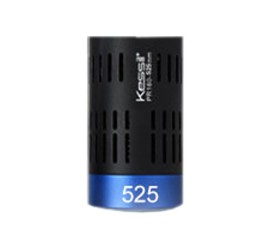PR160L-525nm 藥品燈
LED PhotoReaction Lighting
化學燈使用安裝說明

Newly Designed Linear Reflector
- A linear illumination area with more even light distribution
- Higher intensity than the previous model PR160 – average intensity is up to 30% higher than that of PR160
- Upgrade kit is available if you have the PR160.

Finely Tuned Wavelengths
- Seven precise wavelengths to choose from – 370nm, 390nm, 427nm, 440nm, 456nm, 467nm, 525nm. Customized solution is available (540nm, 595nm, 640nm, 740nm, etc)
- Study in-depth and optimize photoexcitation/photoredox reactions to save time and cost

Increased Intensity for Higher Efficiency
- Intense and penetrating light reduces reaction times and cost (50% brighter than our already intense Kessil H150 Blue)
- 4 levels of intensity control allows you to study the functional relationship between intensity and yield

Flexibility & Simplicity
- Easily configure for different geometries (vials, test tubes, flasks, etc…)
- Add more PR160Ls to scale up your experiment and increase intensity
- Multiple mounting: PR160 Rig w/ Fan Kit, lab clamp, Kessil Gooseneck, etc.

Upgraded PR160 Rig With Fan Kit
- Specifically designed mounting to turn system into photoreactor for typical laboratory photocatalytic reactions
- Full adjustability and secure mounting provides consistency and accuracy
- Comes with a powerful fan to blow air efficiently (proved to be more efficient than clamp desktop fan) to keep the reactions at room temperature as much as possible
- Comes with light-blocking shields for lab safety, which blocks all UV light and most blue light

Designed for Consistency and Reliability
- Easy to operate
- Reliable results and repeatable reactions, perfect for commercial setups or flow photochemistry
- Consistency between every unit
- Peak wavelength within ±1nm*
- Optical output within 3%*
*Standard Deviation

New Products Added!
- UVA LED 370nm for different applications such as general photochemistry, photocycloaddition, UV Curing, etc.
- Replace high pressure mercury lamp. Safer, environmental friendly, longer lifespan.
- Green LED for Photoenzymatic catalysis involving enzymes/protein

※Specifications※
| Power Consumption | 370nm (max 43W) 390nm (max 52W) 427nm / 440nm (max 45W) 456nm (max 50W) 467nm (max 44W) 525nm (max 44W) |
| Input Voltage | 100-240 VAC |
| Operating Temperature | 0 – 40°C / 32 – 104°F |
| Beam Angle | 56° |
| Wavelength Options | 370nm, 390nm, 427nm, 440nm, 456nm, 467nm, 525nm |
| Average Intensity of PR160 series | 352mW/cm2 (measured from 1 cm distance) |
| Dimensions | 4.49″ x 2.48″ / 11.4cm x 6.3cm (H x D) |
※Product Spectrums※

※LED燈源(化學使用)與一般單元不同之說明※
“Photoredox 暫時最主要是在有機化學學術領域,使用光和光催化劑(catalyst) 改變compound, 令原來要用幾個月時間甚至沒有辦法製造的compound 在幾個小時內就可以製造出來。這亦代表藥廠可更快和更便宜拿到造藥原材料
普林斯頓大學的Professor David Macmillan 是這領域的專家和領導者,原先提倡使用一般家用CFL 燈具,因為價格低和容易找到,但是光譜太廣和強度不足,研究慢慢找出光的波長是很重要的一環。這時DiCon/Kessil 的優勢就更顯突出。因為我們是自家製造LED chip 一條龍到燈具,所以我們可以做到很精準的波長,而且燈具的強度亦很足夠,很適合Photoredox 這個應用。美國這邊的藥廠現在都爭先去研究出適當的方法及方程式。世界各地尤其是歐洲的研究所都對這方面很有興趣,希望找出特別的方程式。
最近Macmillan 教授用Photoredox 發明出一種新的藥物測試方法。現在一般的藥物測試都是使用人體去測試藥物到底去到身體那裏,有沒有去到好的地方壞的地方或是好壞的地方也去到,而現在要去追蹤這些藥物是有一定的難度,需要幾個月甚至幾年時間去將藥物變成有輻射性去追蹤。Macmillan 教授使用Photoredox 用幾個小時就改變了藥物的Compound,把藥物變成有輻射性,可以被追蹤,令一般藥物的研發時間由14年左右大幅減少。而教授在這次實驗當中也是使用我們Kessil的燈具,他在他的研究paper都有提及Kessil.”




